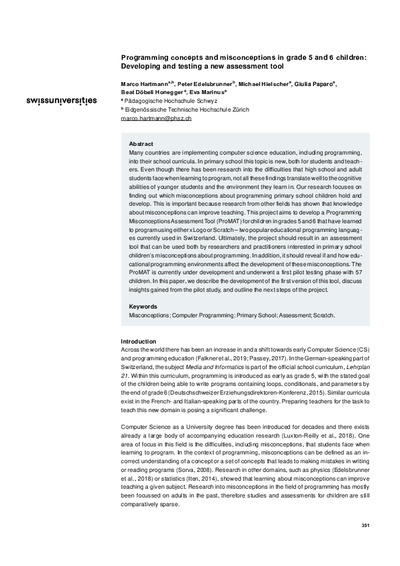Programming concepts and misconceptions in grade 5 and 6 childrenDeveloping and testing a new assessment tool
Marco Hartmann, Peter Edelsbrunner, Michael Hielscher, Giulia Paparo, Beat Döbeli Honegger, Eva Marinus
Publikationsdatum:
Zu finden in: Die Entwicklung der Fachdidaktiken als wissenschaftliche Disziplinen in der Schweiz: Bilanz und Perspektiven (Seite 351 bis 356), 2022
  |
 |
 Diese Seite wurde seit 1 Jahr inhaltlich nicht mehr aktualisiert.
Unter Umständen ist sie nicht mehr aktuell.
Diese Seite wurde seit 1 Jahr inhaltlich nicht mehr aktualisiert.
Unter Umständen ist sie nicht mehr aktuell.
 Zusammenfassungen
Zusammenfassungen


 Many countries are implementing computer science education, including programming,
into their school curricula. In primary school this topic is new, both for students and teachers.
Even though there has been research into the difficulties that high school and adult
students face when learning to program, not all these findings translate well to the cognitive
abilities of younger students and the environment they learn in. Our research focuses on
finding out which misconceptions about programming primary school children hold and
develop. This is important because research from other fields has shown that knowledge
about misconceptions can improve teaching. This project aims to develop a Programming
Misconceptions Assessment Tool (ProMAT) for children in grades 5 and 6 that have learned
to program using either xLogo or Scratch – two popular educational programming languages
currently used in Switzerland. Ultimately, the project should result in an assessment
tool that can be used both by researchers and practitioners interested in primary school
children’s misconceptions about programming. In addition, it should reveal if and how educational
programming environments affect the development of these misconceptions. The
ProMAT is currently under development and underwent a first pilot testing phase with 57
children. In this paper, we describe the development of the first version of this tool, discuss
insights gained from the pilot study, and outline the next steps of the project.
Many countries are implementing computer science education, including programming,
into their school curricula. In primary school this topic is new, both for students and teachers.
Even though there has been research into the difficulties that high school and adult
students face when learning to program, not all these findings translate well to the cognitive
abilities of younger students and the environment they learn in. Our research focuses on
finding out which misconceptions about programming primary school children hold and
develop. This is important because research from other fields has shown that knowledge
about misconceptions can improve teaching. This project aims to develop a Programming
Misconceptions Assessment Tool (ProMAT) for children in grades 5 and 6 that have learned
to program using either xLogo or Scratch – two popular educational programming languages
currently used in Switzerland. Ultimately, the project should result in an assessment
tool that can be used both by researchers and practitioners interested in primary school
children’s misconceptions about programming. In addition, it should reveal if and how educational
programming environments affect the development of these misconceptions. The
ProMAT is currently under development and underwent a first pilot testing phase with 57
children. In this paper, we describe the development of the first version of this tool, discuss
insights gained from the pilot study, and outline the next steps of the project. Dieses Konferenz-Paper erwähnt ...
Dieses Konferenz-Paper erwähnt ...
 Dieses Konferenz-Paper erwähnt vermutlich nicht ...
Dieses Konferenz-Paper erwähnt vermutlich nicht ... 
 Nicht erwähnte Begriffe | Bildung, blockbasierte Programmierumgebungen, Curriculum / Lehrplan, Digitalisierung, Eltern, Fehlvorstellungen bezüglich Variablen |
 Tagcloud
Tagcloud
 Zitationsgraph
Zitationsgraph
 Zitationsgraph (Beta-Test mit vis.js)
Zitationsgraph (Beta-Test mit vis.js)
 1 Erwähnungen
1 Erwähnungen 
- Informatikunterricht im Zyklus 2: Variablen - Eine Design-Based-Research Studie (Lea Gisler) (2024)


 Volltext dieses Dokuments
Volltext dieses Dokuments
 | Programming concepts and misconceptions in grade 5 and 6 children: Kapitel als Volltext ( : :  , 123 kByte) , 123 kByte) |
 Anderswo suchen
Anderswo suchen 
 Beat und dieses Konferenz-Paper
Beat und dieses Konferenz-Paper
Beat hat Dieses Konferenz-Paper während seiner Zeit am Institut für Medien und Schule (IMS) ins Biblionetz aufgenommen. Beat besitzt kein physisches, aber ein digitales Exemplar. (das er aber aus Urheberrechtsgründen nicht einfach weitergeben darf). Es gibt bisher nur wenige Objekte im Biblionetz, die dieses Werk zitieren.









 Kinder
Kinder LehrerIn
LehrerIn Lehrplan 21
Lehrplan 21 Lernen
Lernen LOGO (Programmiersprache)
LOGO (Programmiersprache) Primarschule (1-6) / Grundschule (1-4)
Primarschule (1-6) / Grundschule (1-4) Programmieren
Programmieren Schule
Schule Schweiz
Schweiz Scratch
Scratch Unterricht
Unterricht



 Biblionetz-History
Biblionetz-History